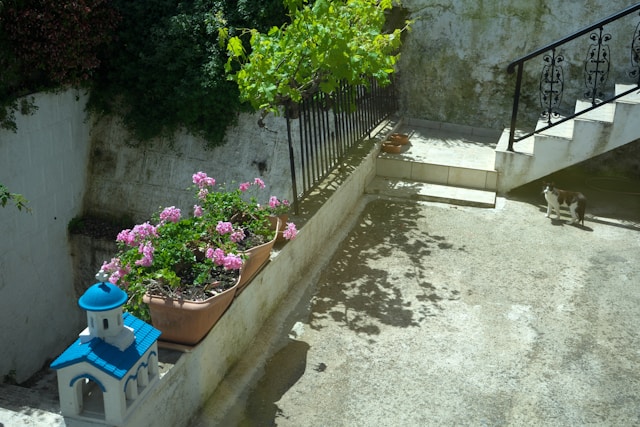
Choosing the right method for cleaning garden patios and driveways can save both time and money. You’ve got two main options: jet washing and scrubbing, each with its own pros and cons. Understanding their differences helps you pick the best one.
A good clean keeps your outdoor areas looking tip-top without overspending or extra effort. Let’s look at what each method offers so you can decide which suits your surfaces and cleaning needs.
Jet Washing: How It Works
Jet washing is a super handy way to clean up outdoor spots using high-pressure water jets to blast away dirt and grime. It’s great for tough stuff like concrete and stone. If you don’t have a jet washer, you can easily rent one from a local shop.
Just keep in mind it uses a lot of water and sometimes chemicals, which isn’t the best for the environment. But hey, it’s way quicker than scrubbing by hand.
Safety’s a big deal, so chuck on some goggles and gloves to keep safe from the strong spray. Make sure to keep a safe distance and keep the nozzle moving so you clean things up without wrecking them. It’s all about finding the sweet spot between being quick and doing a good job.
Scrubbing: A Detailed Approach
Scrubbing’s a great way to clean patios and driveways if you want more control over those tough stains. You can do it by hand or use tools like electric scrubbers.
You’ll need stiff brushes, eco-friendly cleaners, and buckets for rinsing. It works wonders on surfaces like tiles and textured concrete, where dirt gets really stuck in.
Yeah, it takes more time than using a jet washer, but scrubbing lets you tackle specific spots, like oil spills and moss. Plus, you won’t need loads of chemical cleaners, which saves money in the long run.
For the best results, try using circular motions and switch up your brushes based on the surface. It might be hard work, but seeing your patio or driveway spotless is so worth it!
Effectiveness Comparison
Choosing the right way to clean your garden patios and driveways is key to getting rid of different kinds of dirt. Let’s check out how jet washing and scrubbing stack up against each other, looking at what each does best and where they might fall short.
We’ll also see how the type of surface can change how well each method works, with some handy tips to help you decide.
Jet Washing: Quick and Broad Cleaning
Jet washing is great if you need to clean big areas like patios and driveways fast. It’s awesome for blasting away stuff like mud and mildew with high-pressure water, perfect for a quick clean. But, it might not handle really tough dirt as well.
Scrubbing: Targeted Deep Cleaning
When dealing with stubborn stains like oil or moss, scrubbing is your best bet. It lets you focus on those hard-to-clean spots, especially on surfaces that need more care. It’s more work, but it gets the job done where jet washing might not.
Surface Types and Combination Use
The surface you’re working on can really affect which cleaning method works better. Jet washing is great for smooth surfaces like concrete, while scrubbing is better for rough tiles.
Sometimes, using both methods together works best. For example, you could start with jet washing to take care of the surface dirt, then scrub the tough spots.
If you’ve got a greasy driveway, a jet wash can clear the top layer of grime, and scrubbing can handle the oil stains. Just try it out on a small area first to make sure you don’t mess up the surface.
Cost Analysis of Each Method
Imagine you’ve just spruced up your patio with a fresh coat of paint. Now, you’re faced with the choice of keeping it clean: do you go the jet washing route or stick with good old manual scrubbing? Let’s dive into the nitty-gritty of both options to help you decide.
Jet washing can feel like a big upfront splurge. Renting the equipment might set you back between £30 and £70 a day.
You might also need some mild degreaser to get the job done, which adds a bit more to the bill. But here’s the kicker: jet washing can save you time, meaning fewer clean-ups in the long run and a bit more money left in your pocket over time.
Plus, if you can borrow one from a neighbour or your local DIY store, that’s a win. The downside? Jet washing guzzles a lot of water—150 to 300 gallons per session. That’s about 0.9 cubic meters, costing you roughly 30p on your water bill, and it’s not the best for our planet.
On the other hand, scrubbing keeps things simple. Brushes and eco-friendly soaps are cheap, making it easy on your wallet at the start. It’s kinder to the environment too, as it uses less water.
But it’s a workout—more time, more elbow grease, and you might end up using more cleaning products to get that shine.
If you’re thinking of sitting back and hiring the pros, remember that jet washing prices can swing quite a bit. It’s a smart move to check online listings or local flyers for rates and get a few quotes before deciding.
At the end of it all, weigh up the immediate costs against the long-term savings. Consider the environmental impact too. Maybe jot down a quick pros-and-cons list to see what works best for you. Give it a go and let us know how it worked for you!
Time Efficiency: Which Method Wins?
In the hunt for quick and easy cleaning, picking between jet washing and scrubbing can be a game-changer. Each has its pace, and figuring out which suits you helps keep your patios and driveways spotless.
Jet Washing: Fast and Effective
Jet washing is all about speed and getting things done, especially for big areas. It blasts away dirt with high-pressure water, cutting down the cleaning time compared to scrubbing by hand.
Just remember, you’ll need to move stuff out of the way first and let the area dry when you’re done.
Scrubbing: Detailed and Thorough
Scrubbing takes more time and elbow grease, particularly on bumpy surfaces. It’s more work, but it gets into all the little nooks and crannies for a super clean. Breaking the job into sections can help manage your time and make sure you don’t miss a spot.
Tips for Maximising Time Efficiency
To make scrubbing easier, try a power scrubber to save energy and get better results. Cleaning in organised chunks can help you stay on track and not miss anything.
Whether you choose jet washing or scrubbing, it’s all about balancing your time with how clean you want things. Pick the method that fits your schedule and cleaning goals best.
Environmental Considerations: Water Usage and Eco-Friendly Practices
Cleaning your patio or driveway? Think about the environment! Jet washing uses loads of water, like 100 to 300 gallons each time.
But hey, it cuts down on nasty chemicals, so there’s a trade-off. Scrubbing takes way less water, but you might need more cleaning stuff to get the job done.
Want to be eco-friendly? Try using cleaners that break down naturally—they’re kinder to plants and animals. If you’re jet washing, catch the runoff in a bucket to save water.
And always go for non-toxic products to keep things safe. By making smart choices, you can have a clean outdoor space and still look out for the planet.
Conclusion
Choosing between jet washing and scrubbing depends on what you’re cleaning, your budget, and how much time you’ve got. Jet washing is great if you need to clean big, smooth surfaces quickly, while scrubbing works better on tough stains and bumpy areas.
Both have their own benefits, and mixing them up could give you the best results. Think about eco-friendly options and how to keep it clean in the long run—it can really pay off.
By keeping these things in mind, you’ll get a super clean patio or driveway without hurting the environment. Why not try both methods to keep your outdoor spaces looking awesome for longer?

Abdul Qadeer is highly experienced in creating engaging content that adds real value to a blog, website, or brand. He is creating content for multiple niches like technology, SEO, Marketing, Health, Education and Career Development, etc.